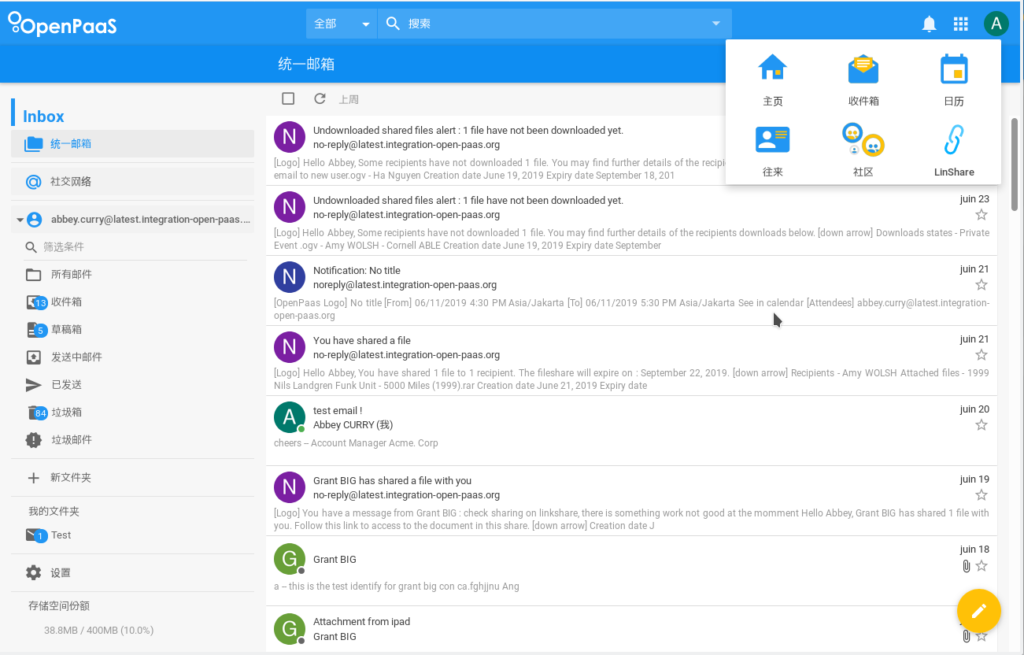OpenPaaS version 1.5., aka Deneb
Release notes for version 1.5.0
The June version of the OpenPaaS platform is available right now, for your testing, and download pleasure. The whole team worked to bring you an even better experience when using our software, as well as providing a new bunch of features. For the first time, we synchronized the release of LinShare, our files and documents service, with the release of the paltform. You’ll find below an overview of the main new features and enhancements.
Below are some of the new features and changes this new release brings on:
LinShare
Files versioning
The development team worked hard to provide a first working version of the file versioning feature on LinShare. When you are working with files in a Shared Space, and you record a file that has the same name than an already existing file, then a new version of the file is created. Users are then allowed to see the different file versions and to go back and forth in time, by promoting any previous version as the current one. This feature opens the door to a number of possibilities, including online edition of documents and desktop synchronization of a filder tree.
Folder download
Linshare users can now download a whole folder tree, that will be sent to the browser as a zip archive.
Unified Inbox
We worked on UnifiedInbox performances, and changed the way that is used under the hood to display emails. This should bring a faster experience. We also worked on improving network requests sent to the backend, still to improve performances. We added a multi-selection shortcut (SHIFT + checkbox selection click) to select a bunch of mails.
We also improved LinShare’s file browser, adding the ability to sort by date or name, and to filter documents by name.


Plateform
Popover on contacts
In a try to ease the communication inside the platform, we added a popover that will fire when you hover your mouse on domain users or contacts. This popover will give you the main information about the current person and provide links to chat, email, and soon launch a video-conference with this user.
This feature, is powered, under the hood, with the new People Search API, which optmimizes the requests to people directories. Currently the platform supports: user contacts, organization members, remote LDAP server.
Per-domain modules activation
Most of OpenPaaS modules can now be enabled and disabled per platform and per domain. This allows SaaS-like offers of OpenPaaS to customize the product to the needs of the customers. Also, it allows to remove unused modules, and offer a not-cluttered interface to the end-users.
Administration
This product iteration had a particular focus on the administration and underlying technical area of the product. We worked a lot to upgrade two of our major underlying software: ElasticSearch, where we upgraded from version 2.4 to version 6.4 on all of our components, and NodeJS, where we upgraded from version 8 to version 10. We took great care to provide a documented LINKLINK process when our users want to upgrade their system.
We also provided GUI to launch a full reindex of OpenPaaS data into ElasticSearch.
We added more environment variable, available to set the initial platform admin user and password, to ease automatic docker deployments.
Email server
S3 support for email storage
The OpenPaaS email server is now capable of storing raw email data in an S3 compatible Object Storage. This will help the big-sized deployments to better scale their Cassandra clusters, by decreasing the amount of data stored in this datastore.
Accessibility
visibility_offDisable flashes
titleMark headings
settingsBackground Color
zoom_outZoom out
zoom_inZoom in
remove_circle_outlineDecrease font
add_circle_outlineIncrease font
spellcheckReadable font
brightness_highBright contrast
brightness_lowDark contrast
format_underlinedUnderline links
font_downloadMark links
Cookies allow us to personalise content and advertisements, provide social media features and analyse our traffic. We also share information about the use of our site with our social media, advertising and analytics partners, who may combine this with other information you have provided to them or that they have collected through your use of their services.
By clicking "Accept All" you consent to the use of ALL cookies.






